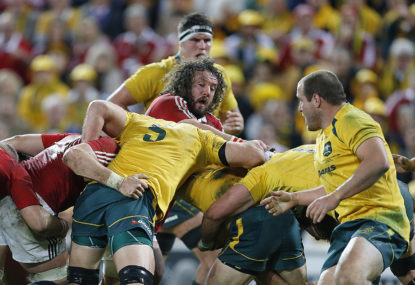Hurricanes head coach Mark Hammett last week raised concerns that many mauls from lineouts are illegal. He’s not the first to make that point and there are a variety of complaints about how mauls are structured.
The commenters on the article reporting Hammett’s comments on The Roar generated a robust debate on what is and is not legal in a maul. Today, I’ll add my thoughts on the subject.
There are two main areas I want to talk about – whether a maul is fair or is just legalised obstruction, and the legality of certain mauling techniques.
Legalised obstruction?
The answer to this question is purely a personal opinion. Many will say that a maul is unfair because the defending team can be blocked from access to the ball by players in front of the ball. Many others will say that a maul is a real contest of strength and technique, both in attack and defence, and is part of the game’s fabric.
Before you rush to the comments section, I’d like you to consider this – if a team scores a pushover try with the ball at the back of a scrum, is that good play or is it legalised obstruction?
What has that got to do with mauls? Well, exactly the same obstruction occurs in a scrum that people complain about in mauls, with only one difference – the ball is on the ground in a scrum and held off the ground in a maul.
Consider the structure of a scrum once the ball has been moved to the back and is trapped at the feet of the number eight.
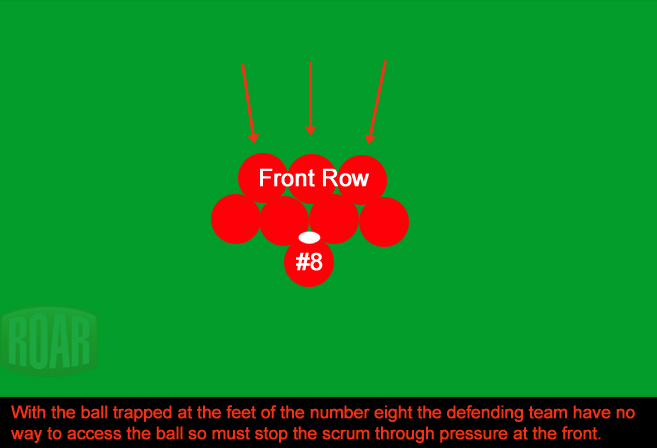
Compare that to the structure of a maul once the ball has been moved to the back.

Obviously some teams like to use a narrower structure for mauls but the structure is very similar.
If the ball gets to the back legally there is no difference between a scrum and a maul – the opposition can be blocked from accessing the ball by players in front of the ball.
Is that fair? I think it is, as long as defending teams have opportunities to contest and stop the ball getting to – and then being held at – the back of a scrum or maul.
In a scrum, as long as the ball is fed reasonably straight, both teams have an opportunity to strike for the ball. In a lineout, as long as the ball is thrown reasonably straight, both teams have an opportunity to compete for the ball in the air.
In a scrum the defending team has the opportunity to drive the attacking team backwards to either win the ball or force them to release the ball from the scrum – in a lineout the defending team has the opportunity to drive the maul backwards to force the attacking team to release the ball.
In both cases if the defending team can stop the scrum or maul from advancing forward, the referee will call for the ball to be released.
In a scrum, the defending team can wheel the scrum, as long as they move forward first, to win possession – in a maul, the defending team can also wheel the maul into touch or into a position where the ball has to be released.
In a lineout there is also the option to pull the jumper down and that may stop the ball getting to the back of a maul. Of course, in scrums there is no option to bring any players down (and nor should there be), so there are less opportunities for the defending team with a scum than there are with a lineout.
All of these options offer the opportunity for a contest and as long as those opportunities exist, I think a maul is a fair contest and it becomes a test of technique and strength to determine the outcome.
What is legal in a maul?
There are four areas I want to discuss regarding legality: setting up the maul, what is a legal bind in a maul, players joining a maul ahead of the ball carrier, and the ball carrier moving backwards through the maul.
Setting up a maul
The key to setting up a maul legally is that the defending team must have access to the ball carrier before a maul forms.
If a defending team cannot win the ball in the air at a lineout, they try to stop the maul being formed because once it is it becomes much more difficult to defend against.
One way to try and stop a maul forming is by sacking the jumper (or bringing them to ground), which is legal as long as it is done before a maul forms, which means almost immediately the jumper comes to ground. Alternatively, the defending team may try to drive on the jumper as soon as they land to disrupt the maul and get it going backwards or sideways as it is being formed.
Regardless of which tactic is used, players cannot sack or drive on the jumper until they are on the ground or they can be penalised for tackling a player in the air.
At the same time the jumper must still have the ball when they come to ground. The attacking team tries to counter the sack or drive by having the jumper hand the ball off to players behind them before the defending team can disrupt. However, you often see the jumper handing the ball off before they land, which is illegal as it denies a contest.
I know from a referees briefing I attended last month that this is something referees are focusing on this year.
The following image from the recent Bulls match against the Chiefs shows a lineout in the 30th minute from which the Bulls scored a try. It shows how tight the decision can be as to whether the jumper still has the ball when they land or has handed it off early.
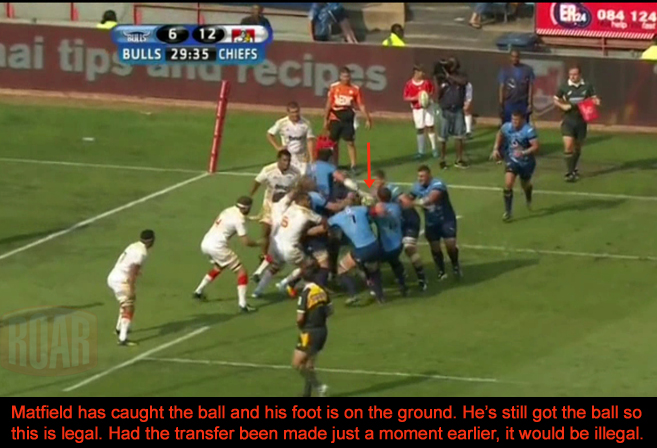
Victor Matfield still has the ball but only just and his foot has only just touched the ground. This transfer is legal and perfectly timed.
Another issue with how the maul is set up is players on the ground obstructing.
If players on the ground get ahead of the jumper before they land they are obstructing the defending team from accessing the jumper. This denies a contest, as the defending team can no longer sack or drive on the jumper when they still have the ball.
This is normally done by the blockers who have just lifted the jumper and is something that referees are watching closely for.
Binding in a maul
I noticed in the comments to last week’s article that some people were making reference to the law saying, “… must use the whole arm from hand to shoulder to grasp the team-mate’s body at or below the level of the armpit. Placing only a hand on another player is not satisfactory binding.”
That definition is from law 20.3 and is specifically for binding in a scrum – it isn’t a definition of binding that applies to mauls.
There is no requirement to grasp a player or where to bind on a player in relation to mauls.
The law regarding binding in a maul simply says “Placing a hand on another player in the maul does not constitute binding”.
Regardless of what the laws say, I’m sure we’ve all heard referees talking about a ‘full arm’ bind and it’s pretty obvious what that means. The definition in law 20.3 regarding scrums also gives a pretty good idea that this means the whole arm from hand to shoulder should be connected in a maul.
In preparing this article I checked my interpretations with a senior referee who has refereed plenty of Super Rugby matches and Test matches. He pointed out an example from the Brumbies and Blues match last weekend where a bind was not legal and should have led to the referee calling an end to the maul.

That maul lasted over ten seconds which should have been enough time for the referee to identify the illegal bind.
Players joining the maul
Hammett’s biggest complaint last week was that players are being allowed to join mauls ahead of the ball carrier.
Law 17.4(c) says, “Players joining a maul must do so from behind the foot of the hindmost teammate in the maul”.
However, that law also says “The player may join alongside this player”.
Therefore, if a player joins ahead of the player at the back of the maul (typically the ball carrier) they are joining illegally. If that’s been occurring I can understand Hammett’s complaint, but if they join alongside the player at the back of the maul it is legal.
Hammett made those complaints in advance of the Hurricanes’ match against the Bulls. The maul that the Bulls scored from against the Chiefs, which I showed you the start of earlier, is typical of the way the Bulls maul.
The first image from this maul above shows that the first two players who joined after the eventual ball carrier joined alongside the player at the back, if not before he even joined the maul.
Following are images that show how the remaining players joined that maul.
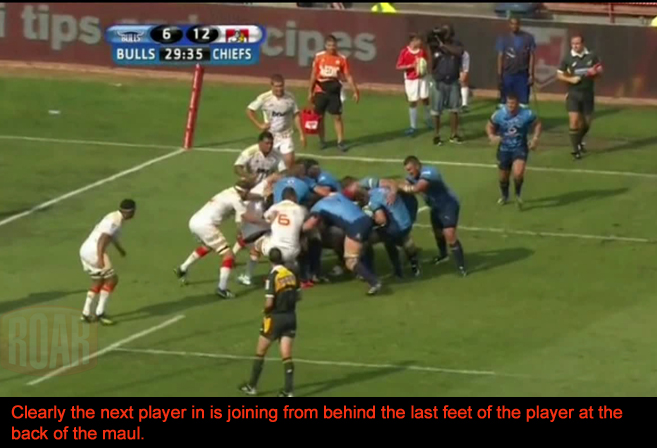

In that particular lineout no player joined ahead of the player at the back of the maul. They did join alongside that player but that is allowed by the laws.
There may be other examples, but the recent Bulls lineouts I looked at didn’t show any obvious trend of players joining in front of the ball carrier.
Incidentally, the Chiefs player pulling a Bulls player out of the maul on the near side is not legal and he could have been penalised – refer to law 17.3(a).
Ball carrier moving back through the maul
As that maul continued, the Bulls’ ball carrier moved backwards so that they ended up right at the back of the maul.
Many people made the comment last week that it is illegal for the ball carrier to move backwards, because to do so they must break their full arm bind which would mean the maul has ended.
That is not correct. The law does not require a player to bind to the maul or even to be bound to the maul at all. In fact the law specifically provides for a player not to be bound to the maul – instead they can be ‘caught in the maul’.
The definitions for mauls include the wording “All the players involved must be caught in or bound to the maul” and law 17.2(b) says, “A player must be caught in or bound to the maul…”
That is why a defending player coming through the middle of a maul can swing their arms over the top of the maul like Will Skelton does to try and wrap the ball carrier up. They may not be bound, but they are surrounded by players and therefore caught in the maul and legal.
Obviously players cannot use this law to ‘swim’ up the outside of a maul as they are not caught in the maul – they are on the outside of the maul.
Being caught in a maul also applies to an attacking player, such as the ball carrier, who is in the middle of a maul and therefore does not have to be bound at all. The ball carrier can be in the middle of the maul and move backwards legally while they have players around them.
You will note from the wording of the laws that there is also no requirement for any player themselves to bind to the maul – they can be bound to the maul by another player binding on to them.
That is particularly relevant for the ball carrier. In fact the definition of a maul says, “A maul begins when a player carrying the ball is held by one or more opponents, and one or more of the ball carrier’s team mates bind on the ball carrier”. It doesn’t specify that the ball carrier has to bind on to the maul.
Therefore, if the ball carrier is at the back of the maul they can have both hands on the ball and still be legal, as long as another player is binding them to the maul.
That also means that the ball carrier can move backwards through the maul as long as another player maintains a bind on them. The player behind the ball carrier can reach forward and bind on the ball carrier, who can then release their own bind on the player in front and slide backwards before binding on the player they have just slid alongside and then move further backwards. It’s just a matter of getting the timing right between players.
Again I checked my interpretation with the senior referee, and my interpretation was confirmed.
I looked at the continuation of that Bulls maul to see if at least one player (either the player alongside or the ball carrier) was bound at all times as the ball carrier moved backwards. The following images show the frame where the ball carrier broke their bind to move backwards.
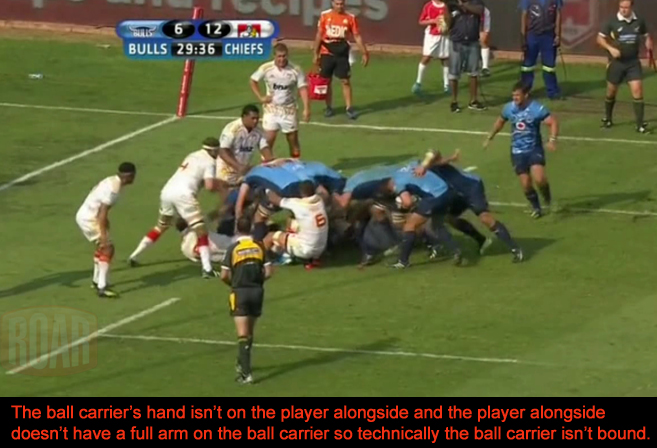
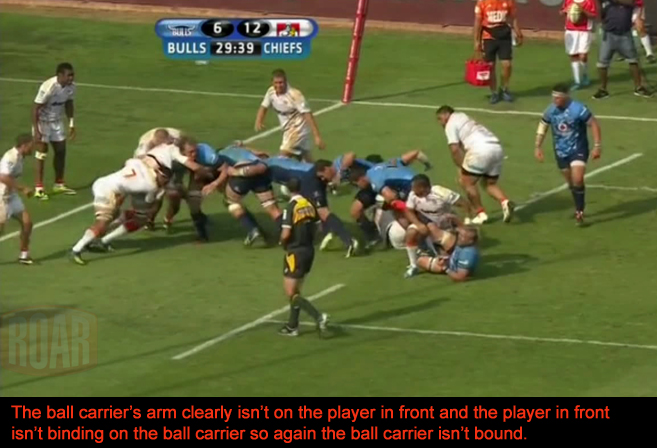

The legality of the bind in the first image depends on pretty small gaps between the players. The second image is clearer and shows the bind was broken, even if only for a short time.
These are frames that I pulled out after doing a frame by frame analysis with each frame representing 1/25th of a second. Try getting the footage to pause so accurately with your remote control because 1/25th of a second goes pretty quickly.
So while it’s easy for me to show you a moment in time where the binds were not legal, the referee has to make a decision on the run without the luxury of a remote control.
If we want to be technical this maul should not have been allowed to continue and the Bulls should have been told to use the ball, but I think it’s unreasonable for a referee to be expected to pick everything up with such small margins involved.
The only way to be more accurate would be to ask the TMO to freeze-frame the footage, which would delay the game further. I hope that doesn’t occur – I’d rather see the referee make the call on-field and accept that mistakes are made by players and referees (and coaches).
Mauls are a try-scoring weapon but they can be defended, so teams need to work on their tactics and techniques to do so.





























































































